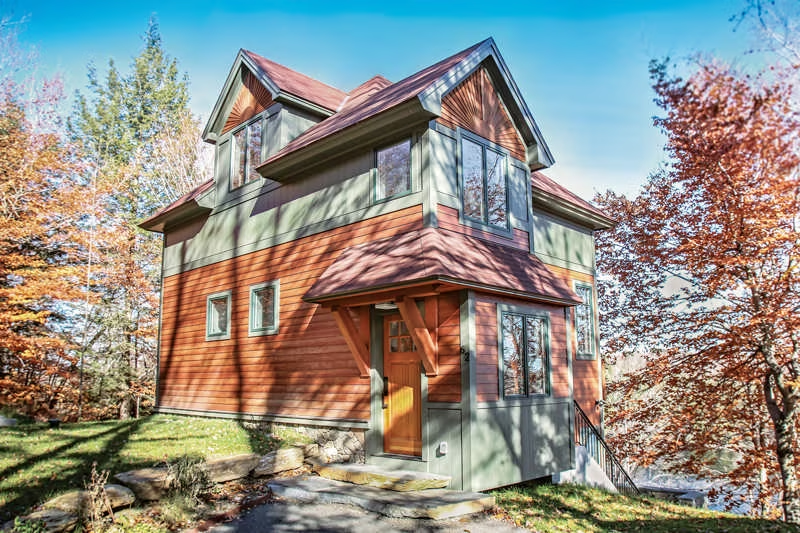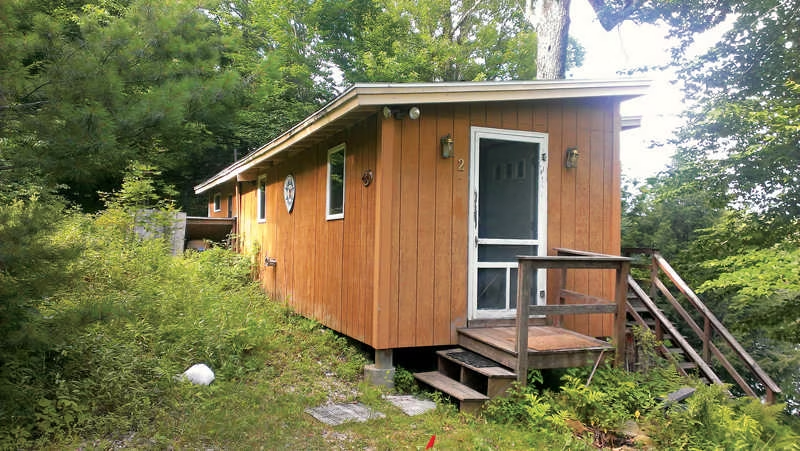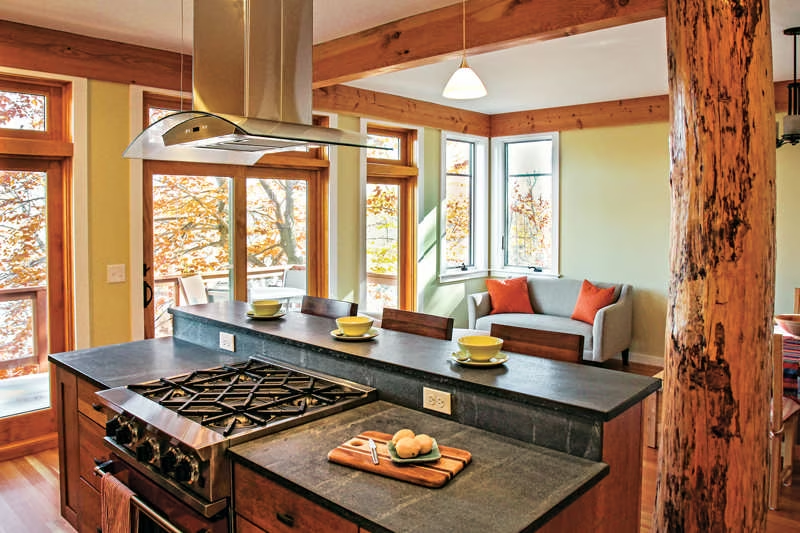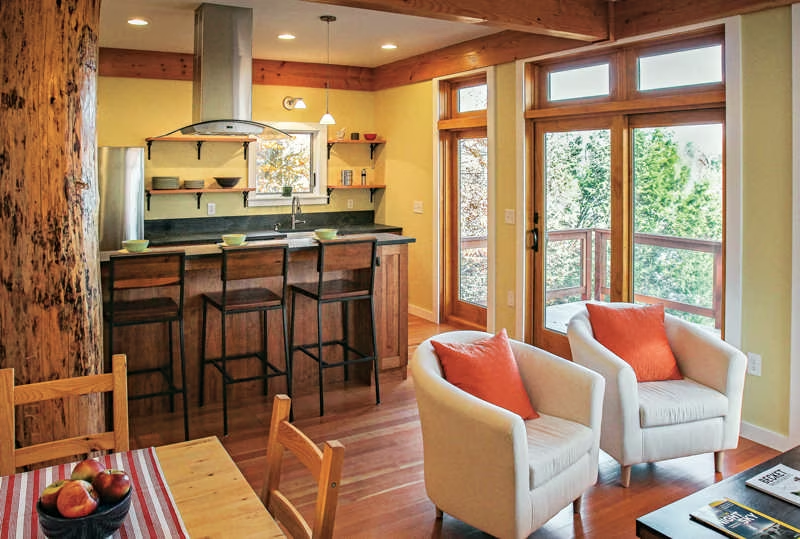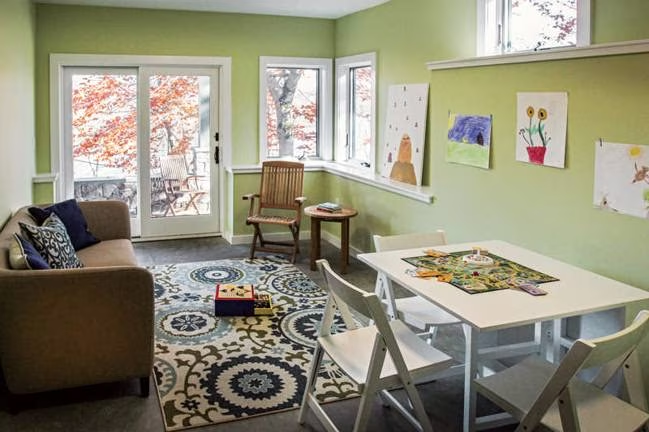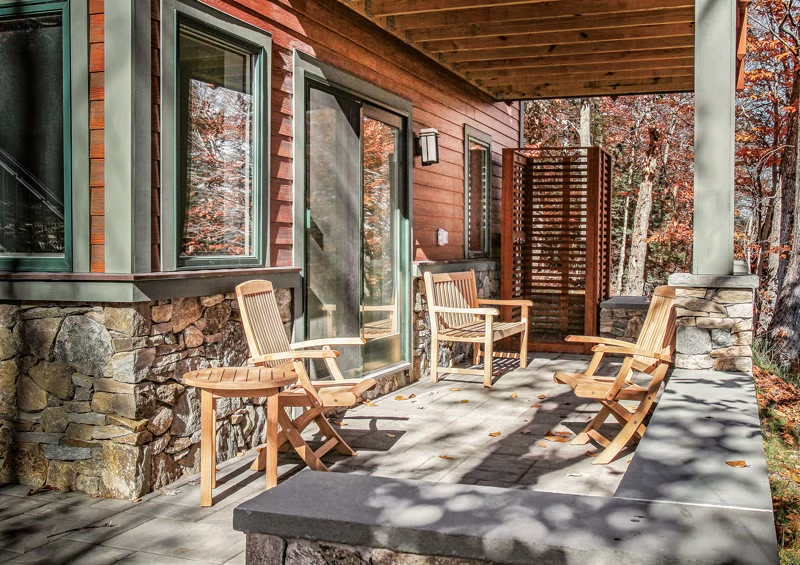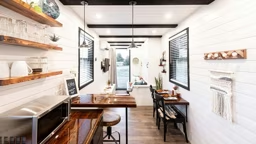This multilevel treehouse-inspired cabin perches on a steep slope overlooking a secluded pond in the Berkshires. Mahogany siding and green upper siding panels look like wood but are actually Allura pre-finished fiber cement. Corner boards, window trim and fascia are an innovative manufactured product from Boral.
Photos by Frank Coleman / Courtesy John Cole Architect
From roots to roof, all of this Massachusets cabin's components work as a system to maximize energy efficiency. John Saveson, energy analyst at the Center for EcoTechnology in Pittsfield, Mass., and the HERS rater who assessed the cabin, explains the reasons why it performs so well below. Whether you’re remodeling an older cabin, replacing Grandpa’s old icebox, or just changing a light bulb, here are some tips to make your cabin a little more green. (For more on this home, tour it here.)
7 Energy Efficient Ideas to Steal
1. Size
For starters, the cabin is fairly compact – a good thing from an energy standpoint. Without rambling lines, angles or dormers to add complexity, it has a higher volume-to-surface-area ratio.
2. Insulation
The whole volume of the cabin is well insulated. One big benefit, says Saveson, is that all mechanical equipment and ductwork in the basement are contained within that insulated shell, so any leakage is to space within the heated envelope.
3. Windows
Windows are a big contributing factor to a cabin’s energy efficiency. The ones in this cabin are Anderson 400 series.
4. Heating
A Carrier high-efficiency (96%) propane furnace with a variable speed ecm (electronically commutated motor) uses a very low amount of electricity to move air through the cabin.
5. Appliances
Energy Star certified models reduce energy and water use and save on fuel bills. The appliances here include an LG refrigerator, washer and dryer and a Bosch dishwasher.
6. Water Heater
Conventional water heaters are notorious energy guzzlers. A heat pump water heater, like the one at this cabin and is a Rheem, is much more efficient. As a bonus, the Rheem electric water heater also acts as a cooling system and dehumidifier. “Basically, it’s like a fridge running in reverse,” says Saveson, “extracting heat from its surroundings to heat the water. So it actually cools off the space it’s in.”
7. Lighting
The cabin has more than 90% efficient lighting.
Bright Ideas for Energy Efficient Lighting
Christine McVinney, lighting specialist at Wolfers Lighting in Allston, Mass., made sure the lighting at this cabin meets Energy Star criteria and is stylish, too. “Our goal was to keep a cabin feel that was updated for this young couple.” Fixtures are Arts and Crafts style with simple lines. Most are LED. “That was a very important part,” stresses McVinney. “Every fixture had to have an integrated LED or accept a particular LED bulb, so the owners could get their certification.” Here are some of the lighting options at this Berkshire hideaway:
-
A 5W LED outdoor safety floodlight with motion sensor by RAB Lighting is “small and discreet,” says McVinney, “but does a great job.”
-
Outdoor wall fixtures by Kichler take compact florescent bulbs.
-
The 3-light chandelier by Kichler had standard based sockets, so McVinney did a retrofit LED. “That was important because we needed enough lighting over the dining room table.”
-
Downlights in the kitchen are surface mounted instead of recessed. Each 14W LED flat panel by Phillips produces 1000 lumens – “a great amount of light,” notes McVinney.
-
A bell-shaped wall sconce over the kitchen sink matches the 6W LED Domi pendants by Besa Lighting. “A 6 watt LED fixture gives you the equivalent of a 50 watt halogen,” says McVinney.
-
LED strips by ION Lighting were installed in the floating shelves in the kitchen.
-
“Long-lasting, energy-efficient fixtures and light bulbs is where we’re going these days,” notes McVinney. “Typically, in second or third homes, it eliminates maintenance. It’s great lighting, runs cool and owners don’t have to worry about changing bulbs often.”
SOURCE: Wolfers Lighting, wolfers.com
Build Tight, Ventilate Right for Ultimate Efficiency
Building as tight a cabin as you can prevents unnecessary heat loss – particularly in winter. The mantra is also a requirement for the Mass Save incentive program. The HERS assessment verified that this retreat is well insulated and air sealed.
Architect John Cole opted for the new Zip System R-sheathing panels by Huber to wrap exterior walls. The panels have a half-inch layer of rigid insulation that creates a thermal barrier, preventing cold and warm air migrating out. Horton sprayed closed-cell foam between the rafters under the hip roof and in the basement box sills (the area at the end of the floor joists that’s exposed to the outside). Duct walls for the forced hot air system are double insulated. The rest of the cabin has R-21 fiberglass insulation.
“This cabin is very tight,” says Saveson. “That’s not easy to achieve with a small house, which tends to have a high surface-to-volume ratio.” It’s also well-ventilated. A high-efficiency NuTone bath fan runs quietly (less than 1.5 sones, whereas a typical fan rates at about 4.0 sones. A sone is a measurement unit of loudness.) and continuously in the basement bathroom, pulling in fresh air and exhausting stale air at 40 cubic feet per minute (cfm). A motion sensor boosts speed to 80 cfm.
“It achieved a 1.2 air change rate during the blower door test,” says Saveson. Typically a house is considered tight at anything less than 5 or 6.
RESOURCE: Huber Engineered Woods, huberwood.com/zipsystem/products/zip-system-rsheathing



